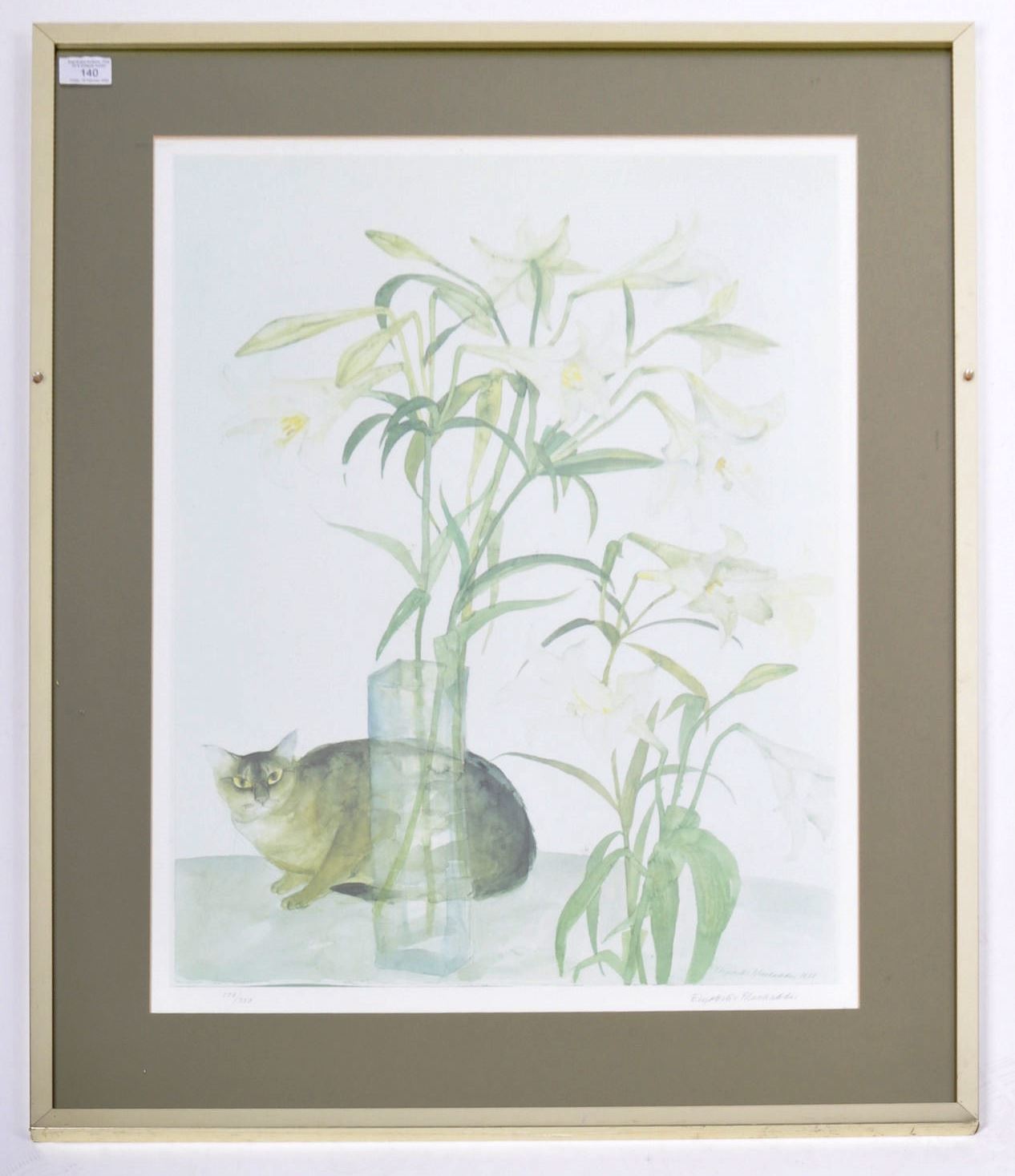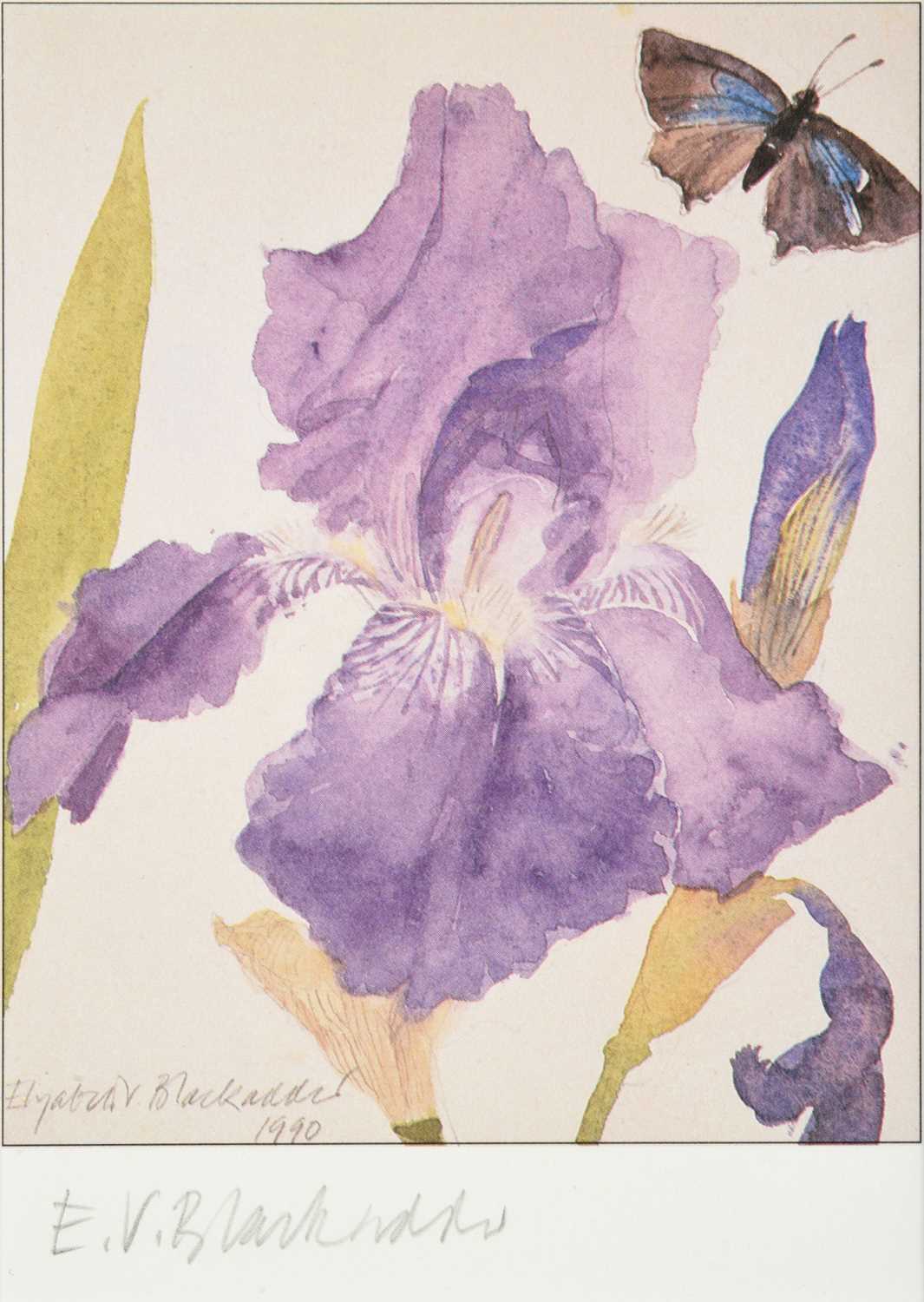artist's proof lithograph on paper, signed and inscribed 'Artist's Proof' mounted, framed and under glass image size 51cm x 68cm, overall size 69cm x 87cm Note: Fifeshire Farm (1960) speaks to Elizabeth Blackadder’s fascination with nature that began during childhood. The wild and wind-beaten trees relate to the artist’s dislike of ‘effete’ garden flowers, and subsequent preference for a ‘laissez-faire’ gardening style, with resultant neo-Romantic landscapes a frequent subject of her work. Blackadder first experimented with printmaking whilst studying at Edinburgh in the early 1950s. She proceeded to produce various lithographs in the 1960s with the Curwen Studio, during a period of renewed interest in the medium. This particular print was made in the same year as Italian Landscape (1960) – a lithograph that shares the restrained colour palette and depiction of harsh-black trees. Recipient of a travel scholarship, Blackadder created these prints following nine months in Italy, beginning from summer 1955. The bare winter trees of Tuscany appealed to the artist, and this continued interest is apparent in Fifeshire Farm. Similar forms are transposed to depict the harsh shrubbery of Fifeshire (or Fife), an area of eastern Scotland and birthplace of her husband and travel partner, John Houston Tate Britain hold a copy of Fifeshire Farm. Note 2: Dame Elizabeth Blackadder is widely recognised as one of Scotland's most significant twentieth-century artists. Born in Falkirk, she studied at Edinburgh College of Art under the tutelage of Sir Robin Philipson and William Gillies and lectured at the college from 1962 until her retirement in 1986. After graduating in 1954, Blackadder was awarded both a Carnegie Travelling Scholarship and an Andrew Grant Postgraduate Scholarship. She used these funds to spend three months travelling through Yugoslavia, Greece and Italy, where she researched classical and Byzantine art. This founded a passion for travel which has continued through her prolific career. Elected as a member of the Royal Scottish Academy in 1972 and the Royal Academy in 1976, she was the first woman to become a member of both institutions. Sixty-six of her works are known to be held in UK public collections.
artist's proof lithograph on paper, signed and inscribed 'Artist's Proof' mounted, framed and under glass image size 51cm x 68cm, overall size 69cm x 87cm Note: Fifeshire Farm (1960) speaks to Elizabeth Blackadder’s fascination with nature that began during childhood. The wild and wind-beaten trees relate to the artist’s dislike of ‘effete’ garden flowers, and subsequent preference for a ‘laissez-faire’ gardening style, with resultant neo-Romantic landscapes a frequent subject of her work. Blackadder first experimented with printmaking whilst studying at Edinburgh in the early 1950s. She proceeded to produce various lithographs in the 1960s with the Curwen Studio, during a period of renewed interest in the medium. This particular print was made in the same year as Italian Landscape (1960) – a lithograph that shares the restrained colour palette and depiction of harsh-black trees. Recipient of a travel scholarship, Blackadder created these prints following nine months in Italy, beginning from summer 1955. The bare winter trees of Tuscany appealed to the artist, and this continued interest is apparent in Fifeshire Farm. Similar forms are transposed to depict the harsh shrubbery of Fifeshire (or Fife), an area of eastern Scotland and birthplace of her husband and travel partner, John Houston Tate Britain hold a copy of Fifeshire Farm. Note 2: Dame Elizabeth Blackadder is widely recognised as one of Scotland's most significant twentieth-century artists. Born in Falkirk, she studied at Edinburgh College of Art under the tutelage of Sir Robin Philipson and William Gillies and lectured at the college from 1962 until her retirement in 1986. After graduating in 1954, Blackadder was awarded both a Carnegie Travelling Scholarship and an Andrew Grant Postgraduate Scholarship. She used these funds to spend three months travelling through Yugoslavia, Greece and Italy, where she researched classical and Byzantine art. This founded a passion for travel which has continued through her prolific career. Elected as a member of the Royal Scottish Academy in 1972 and the Royal Academy in 1976, she was the first woman to become a member of both institutions. Sixty-six of her works are known to be held in UK public collections.















Testen Sie LotSearch und seine Premium-Features 7 Tage - ohne Kosten!
Lassen Sie sich automatisch über neue Objekte in kommenden Auktionen benachrichtigen.
Suchauftrag anlegen